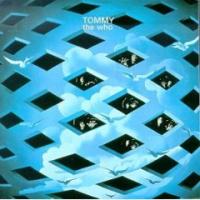Classic's New Tommy Gives You The Original Track Experience Plus!
Let’s get one thing straight here first. No reissue label and mean none goes to the trouble Classic does to get the packaging right. Get your hands on this Tommy reissue and compare it to the original UK Track edition and you will see that Classic has gone the extra 3000 miles to give you as close a facsimile of the original British pressing as is humanely possible.
That means the triple gatefold outer jacket is shiny-laminated while the inner paper showing the sconces (or whatever you call the wall hanging lights) is a soft muted textured paper. If I knew more about paper I could describe it better but I don’t. Getting the reissue correct means that the two LPs slide into the third pane of the jacket one LP from either side, and never the twain shall meet. What’s more, the paper of that particular pane has to have a certain soft, opaque texture and grain. To maintain authenticity the libretto needs to be of a certain paper stock and opacity as well.
Classic got all of this spot-on, including the cover’s deep blue color. Those used to the American Decca will find it hyper-toned, but take my word for it, it perfectly duplicates the Track original, but not later Track pressings, which were muted in color and not laminated.
I am well aware of all of this because I lent Classic my less than pristine second Track original to use both for the artwork and to play on the lathe to compare with the mastertape. And the master tape it was: spliced in places and with paper bands between the tunes.
Watching Chris Bellman compare the original pressing with the tape helped make clear some of the problems inherent in producing a reissue such as this. There were all sorts of odd discrepancies between the tape and LP, including running pitch and EQ changes that required duplicating if the reissue was to be faithful to the original. Should the tape have just run along with the cutter head, the resulting reissue would not have been an accurate rendering of the original pressing. That is not always the goal, but in this case it was and should have been.
The master was putty in the hands of the original LP mastering engineer, no doubt taking direction from producer Kit Lambert. Here, with no guidance from Lambert and no mastering notes in the tape boxes, Chris Bellman had to do real-time “A/B”'s between the tape and the original LP. Not an easy job but one he did with great care as I observed, with Bellman furiously scribbling notes as he went.
I'm sure he listened numerous times more before actual lacquers were cut and the set was put into production. For one thing, I was sent home with 45rpm lacquers of a few tunes and while they sound incredible, I found the top end way too hard and sterile. That's absolutely not the case with these LPs.
Does the reissue sound identical to the original? No. That would be nearly impossible for a variety of reasons but this Classic reissue beats the original in many important ways, while falling short in a few others. While it lacks a certain creamy smoothness and “pop” found on the original, it offers far greater resolution of inner detail, much improved overall clarity and especially greater image focus, and it does so without sounding bright, edgy or overly analytical as some Classic titles do.
The bottom end is exceptionally cleanly drawn and trounces the original in that regard. Also vastly superior to the original are dynamics as well as instrumental and vocal textures. Moon’s drum kit doesn’t quite have the addictive “pop” of the original but what it lacks there is more than made up for by far greater textural and timbral accuracy and transparency. Even if you own a clean first press Track, you will hear details and “expressiveness” you’ve never before heard, especially from Daltry’s vocals and it’s all done without hyper-active high frequencies, though if you don’t like the sound of Bernie Grundman’s lathe at the very top, this reissue won’t make you a converted enthusiast. However, you’ll definitely come away respectful as this double set has texture, detail, transient clarity and warmth where appropriate.
It's worth picking up just for the added luster and resolve of Daltrey's stunning vocal performance. The sonic clarity of this reissue strips away a bit of the original’s mystery but it’s a worthwhile tradeoff for the detail it reveals. Sort of like cleaning years of grime from an old fresco.
As for the music, Who revisionists tend to discount Tommy relative to older Who albums like Sell Out, but in America at least, The Who were tiny until this album put them on the musical map. I saw them perform “Tommy” in front of a few hundred people at the Boston Tea Party in the fall of 1969. By early next winter they’d sold out the Boston Armory thanks to the pull of the second rock opera (the first being “S.F. Sorrow” by The Pretty Things).
Almost forty years later when the band launches into the finale's “Listening to you I get the music” chorus it still brings chills. This Classic Records reissue is one of the label’s finest efforts physically and sonically and is one you will not regret buying, if just for what it reveals about Daltrey’s exceptionally nuanced performance. Kudos to all involved!


